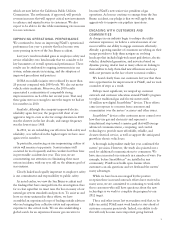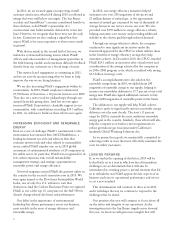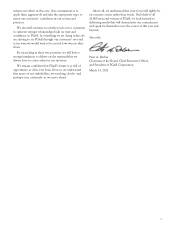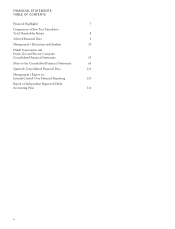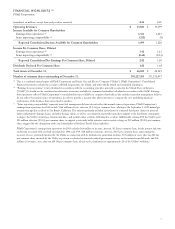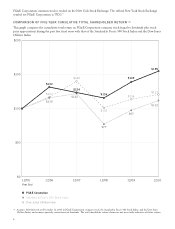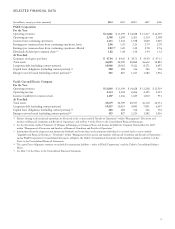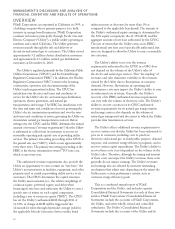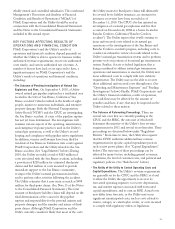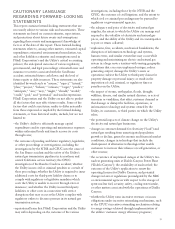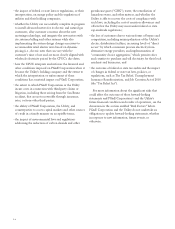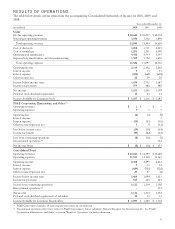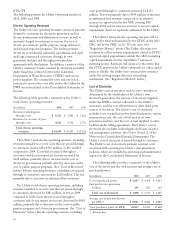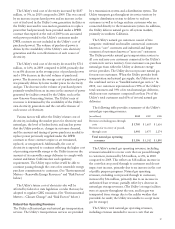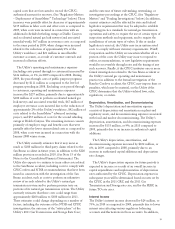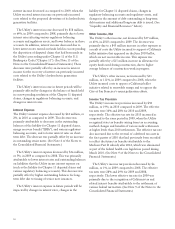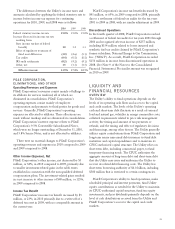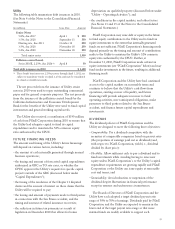PG&E 2010 Annual Report Download - page 17
Download and view the complete annual report
Please find page 17 of the 2010 PG&E annual report below. You can navigate through the pages in the report by either clicking on the pages listed below, or by using the keyword search tool below to find specific information within the annual report.CAUTIONARY LANGUAGE
REGARDING FORWARD-LOOKING
STATEMENTS
This report contains forward-looking statements that are
necessarily subject to various risks and uncertainties. These
statements are based on current estimates, expectations,
and projections about future events and assumptions
regarding these events and management’s knowledge of
facts as of the date of this report. These forward-looking
statements relate to, among other matters, estimated capital
expenditures; estimated environmental remediation, tax,
and other liabilities; estimates and assumptions used in
PG&E Corporation’s and the Utility’s critical accounting
policies; the anticipated outcome of various regulatory,
governmental, and legal proceedings; estimated losses and
insurance recoveries associated with the San Bruno
accident; estimated future cash flows; and the level of
future equity or debt issuances. These statements are also
identified by words such as “assume,” “expect,” “intend,”
“plan,” “project,” “believe,” “estimate,” “target,” “predict,”
“anticipate,” “aim,” “may,” “might,” “should,” “would,”
“could,” “goal,” and “potential,” and similar expressions.
PG&E Corporation and the Utility are not able to predict
all the factors that may affect future results. Some of the
factors that could cause future results to differ materially
from those expressed or implied by the forward-looking
statements, or from historical results, include, but are not
limited to:
• the Utility’s ability to efficiently manage capital
expenditures and its operating and maintenance expenses
within authorized levels and timely recover its costs
through rates;
• the outcome of pending and future regulatory, legislative,
or other proceedings or investigations, including the
investigations by the NTSB and CPUC into the cause of
the San Bruno accident and the safety of the Utility’s
natural gas transmission pipelines in its northern and
central California service territory; the CPUC
investigation of the Rancho Cordova accident; whether
the Utility incurs civil or criminal penalties as a result of
these proceedings; whether the Utility is required to incur
additional costs for third-party liability claims or to
comply with regulatory or legislative mandates which
costs the Utility is unable to recover through rates or
insurance; and whether the Utility incurs third-party
liabilities or other costs in connection with service
disruptions that may occur as the Utility complies with
regulatory orders to decrease pressure in its natural gas
transmission system;
• reputational harm that PG&E Corporation and the Utility
may suffer depending on the outcome of the various
investigations, including those by the NTSB and the
CPUC; the outcome of civil litigation; and the extent to
which civil or criminal proceedings may be pursued by
regulatory or governmental agencies;
• the adequacy and price of electricity and natural gas
supplies, the extent to which the Utility can manage and
respond to the volatility of electricity and natural gas
prices, and the ability of the Utility and its counterparties
to post or return collateral;
• explosions, fires, accidents, mechanical breakdowns, the
disruption of information technology and systems,
human errors, and similar events that may occur while
operating and maintaining an electric and natural gas
system in a large service territory with varying geographic
conditions that can cause unplanned outages; reduce
generating output; damage the Utility’s assets or
operations; subject the Utility to third-party claims for
property damage or personal injury; or result in the
imposition of civil, criminal, or regulatory fines or
penalties on the Utility;
• the impact of storms, earthquakes, floods, drought,
wildfires, disease, and similar natural disasters, or acts of
terrorism or vandalism, that affect customer demand or
that damage or disrupt the facilities, operations, or
information technology and systems owned by the
Utility, its customers, or third parties on which the Utility
relies;
• the potential impacts of climate change on the Utility’s
electricity and natural gas businesses;
• changes in customer demand for electricity (“load”) and
natural gas resulting from unanticipated population
growth or decline, general economic and financial market
conditions, changes in technology that include the
development of alternative technologies that enable
customers to increase their reliance on self-generation, or
other reasons;
• the occurrence of unplanned outages at the Utility’s two
nuclear generating units at Diablo Canyon Power Plant
(“Diablo Canyon”); the availability of nuclear fuel; the
outcome of the Utility’s application to renew the
operating licenses for Diablo Canyon; and potential
changes in laws or regulations promulgated by the NRC
or environmental agencies with respect to the storage of
spent nuclear fuel, security, safety, cooling water intake,
or other matters associated with the operations at Diablo
Canyon;
• whether the Utility earns incentive revenues or incurs
obligations under incentive ratemaking mechanisms, such
as the CPUC’s incentive ratemaking mechanism relating
to energy savings achieved through implementation of
the utilities’ customer energy efficiency programs;
13


